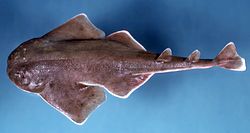Fossil content
Mammals
| Carnivorans | |||||
|---|---|---|---|---|---|
| Genus | Species | Presence | Material | Notes | Images |
| ? Amphictis | Jones County. [3] | A right mandible (NCSM 33670). [3] | An ailurid. | ||
| Cetaceans | |||||
|---|---|---|---|---|---|
| Genus | Species | Presence | Material | Notes | Images |
| Albertocetus | A. meffordorum | Isolated right petrosal (USNM 559392). [4] [5] | A xenorophid. |  | |
| Ankylorhiza | A. tiedemani | CCNHM 6045 (a well preserved 10th lower postcanine). [5] | An odontocete. |  | |
| A. sp. | CCNHM 5554 (an isolated postcanine) and CCNHM 5465 (a partial bulla). [5] | An odontocete. |  | ||
| Cotylocara | cf. C. sp. | CCNHM 4277 (a partial left bulla)". [5] | A xenorophid. |  | |
| Echovenator | E. sp. | A fragmentary petrosal. [4] | A xenorophid. | ||
| cf. E. | Partial tympanic bullae. [5] | A xenorophid, possibly the same taxon as Echovenator sp. [5] | |||
| Eomysticetidae | Eomysticetidae indet. | CCNHM 1831 and CCNHM 1821, both are right tympanic bullae. [5] | An indeterminate species most similar to (but sti differing from) Eomysticetus whitmorei. | ||
| cf. Eoplatanista | cf. E. sp. | "CCNHM 4276 (a partial right tympanic bulla)". [5] | |||
| Eurhinodelphinidae | Eurhinodelphinidae indet. | CCNHM 1828 (a partial right periotic) and CCNHM 4274 (a partial left tympanic bulla). [5] | "Compares favorably with Xiphiacetus cristatus and Eurhinodelphis cocheteuxi". [5] | ||
| ?Kentriodontidae | ?Kentriodontidae indet. | "CCNHM 4275 (a partial bulla)". [5] | |||
| Odontocete | Indeterminate | Belgrade Quarry. [4] | CCNHM 1903 (an isolated tooth). [5] | Indeterminate toothed whale remains, may represent a squalodelphinid or kentriodontid. | |
| cf. Physeteroidea | cf. Physeteroidea indet. | "CCNHM 1904 (a partial tooth)". [5] | May represent a juvenile physeteroid tooth. | ||
| Squalodelphinidae | Squalodelphinidae indet. | 3 right periotics and 3 right tympanic bullae. [5] | |||
| cf. Squalodon | cf. S. sp. | A periotic and multiple teeth. [5] | A squalodontid. |  | |
| Waipatiidae | Waipatiidae indet. | "CCNHM 1354 (a posterior lower molar)". [5] | |||
| Xenorophidae | Xenorophidae indet. | "CCNHM 1833 (a partial right squamosal)". [5] | "Falls within the size range of Albertocetus , Echovenator , and Inermorostrum ." [5] | ||
| Xenorophus | X. sp. | CCNHM 1826 (a partial postcanine) and CCNHM 1187 (a partial tympanic bulla). [5] | A xenorophid, may represent X. sloanii. | ||
| Sirenians | |||||
|---|---|---|---|---|---|
| Genus | Species | Presence | Material | Notes | Images |
| Crenatosiren | C. olseni | Onslow Beach. [5] | Skull caps. [5] | An early dugongid. | |
| Sirenia | Sirenia indet. | "CCNHM 1906 (a partial rib fragment)". [5] | "Approximately twice the diameter of ribs of Crenatosiren olseni, potentially representing a larger dugongid like Dioplotherium , Stegosiren , or Priscosiren ". [5] | ||
Reptiles
| Reptiles | |||||
|---|---|---|---|---|---|
| Genus | Species | Presence | Material | Notes | Images |
| Chelonioidea | Belgrade Quarry. [4] | Indeterminate sea turtle remains. | |||
| Crocodilia | Belgrade Quarry. [4] | Indeterminate crocodilian remains. | |||
Fish
Color key
| Notes Uncertain or tentative taxa are in small text; |
| Chondrichthyes | |||||
|---|---|---|---|---|---|
| Genus | Species | Presence | Material | Notes | Images |
| Anoxypristis | A. sp. | Belgrade Quarry. [4] | A sawfish. | ||
| Carcharhinus | Belgrade Quarry. [4] | ||||
| Carcharias | C. sp. | Belgrade Quarry. [4] | A sand shark. | ||
| Carcharocles | C. angustidens | Belgrade Quarry. [4] | A megatooth shark, now reassigned to the genus Otodus . | ||
| Galeocerdo | G. casei or mayumbensis | Belgrade Quarry. [4] | A tiger shark. | ||
| Ginglymostoma | G. delfortriei | [6] | A nurse shark. | ||
| Hemipristis | H. serra | Belgrade Quarry. [4] | A snaggletooth shark. |  | |
| Myliobatis | M. sp. | Belgrade Quarry. [4] | An eagle ray. |  | |
| Nebrius or Ginglymostoma | Belgrade Quarry. [4] | A nurse shark. | |||
| Negaprion | Belgrade Quarry. [4] | A lemon shark. |  | ||
| Notorynchus | N. primigenius | Belgrade Quarry. [4] | A cow shark. | ||
| Odontaspis | O. sp. | Belgrade Quarry. [4] | A sand shark. | ||
| Otodus | O. angustidens | Belgrade Quarry. [4] | A megatooth shark. |  | |
| Plinthicus | P. stenodon | Belgrade Quarry. [4] | An extinct ray. | ||
| Physogaleus | P. aduncas | Belgrade Quarry. [4] | A ground shark. | ||
| Rhinoptera | R. sp. | Belgrade Quarry. [4] | A cownose ray. |  | |
| Squatina | S. sp. | Belgrade Quarry. [4] | An angelshark. |  | |
| Osteichthyes | |||||
|---|---|---|---|---|---|
| Genus | Species | Presence | Material | Notes | Images |
| Lagodon | L. sp. | Belgrade Quarry. [4] | A pinfish. |  | |
Invertebrates
| Molluscs | |||||
|---|---|---|---|---|---|
| Genus | Species | Presence | Material | Notes | Images |
| Crassostrea | C. gigantissima | Upper finer grained unit, Pollocksville Member. [2] [4] | An oyster. | ||
